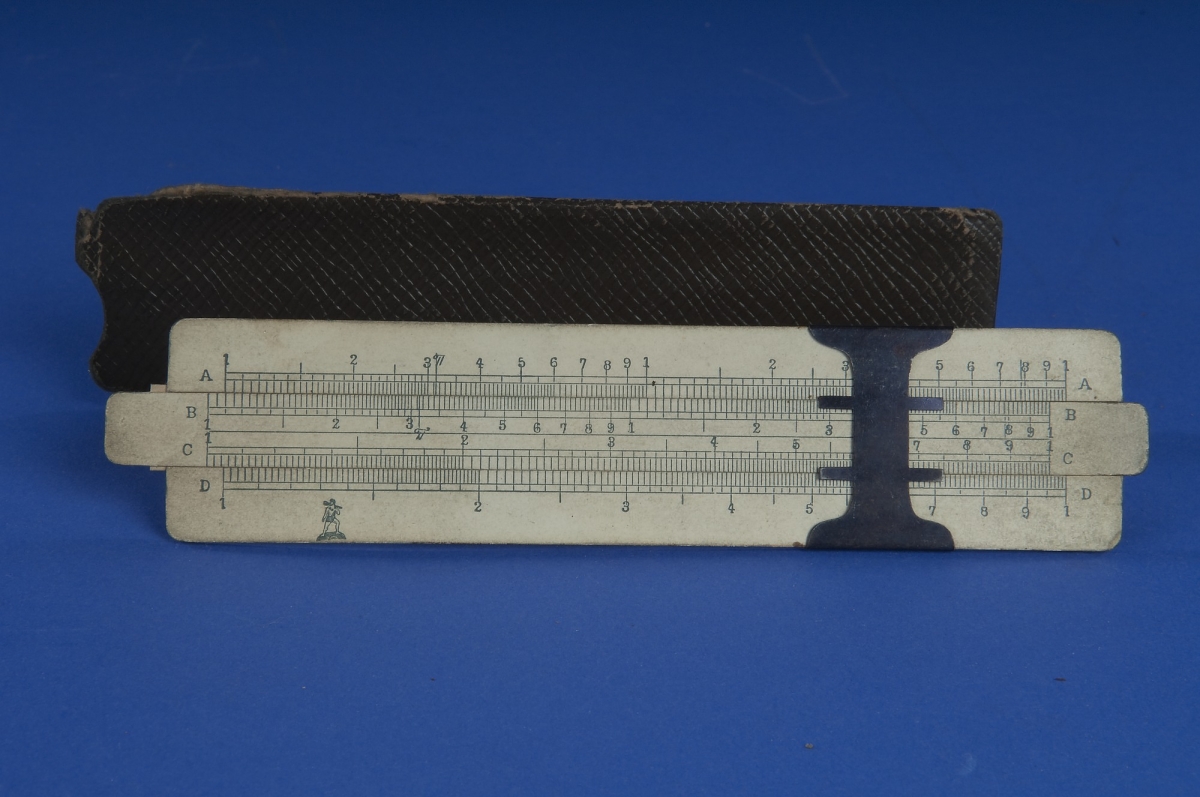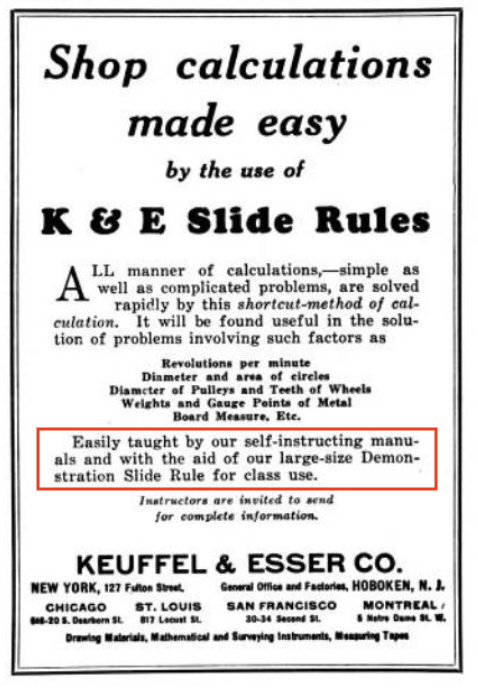- About MAA
- Membership
- MAA Publications
- Periodicals
- Blogs
- MAA Book Series
- MAA Press (an imprint of the AMS)
- MAA Notes
- MAA Reviews
- Mathematical Communication
- Information for Libraries
- Author Resources
- Advertise with MAA
- Meetings
- Competitions
- Programs
- Communities
- MAA Sections
- SIGMAA
- MAA Connect
- Students
- MAA Awards
- Awards Booklets
- Writing Awards
- Teaching Awards
- Service Awards
- Research Awards
- Lecture Awards
- Putnam Competition Individual and Team Winners
- D. E. Shaw Group AMC 8 Awards & Certificates
- Maryam Mirzakhani AMC 10 A Awards & Certificates
- Two Sigma AMC 10 B Awards & Certificates
- Jane Street AMC 12 A Awards & Certificates
- Akamai AMC 12 B Awards & Certificates
- High School Teachers
- News
You are here
Keys to Mathematical Treasure Chests: Classroom Slide Rules – Rules for Demonstration
For about 200 years, slide rules in Europe were largely handmade and used mainly for specialized tasks such as carpentry and computing excise taxes on barrels of liquor. After 1850, at least three developments fostered mass production and adoption of linear (rectangular), general-purpose slide rules:
- In the instructions that accompanied his 1851 modification of a slide rule, French artillery officer Amedée Mannheim (1831–1906) suggested a selection and arrangement of scales that soon became standard, and he devised a cursor [Mannheim 1853; Cajori 1909, pp. 63–65].
- By the 1870s, German manufacturers coated wooden slide rules with celluloid (an early plastic), making them more durable and less expensive.
- Dividing engines and advanced printing techniques allowed accurate scales to be imprinted in large numbers [Ackerberg-Hastings 2012].

Figure 3. Gebr. Wichmann Mannheim Simplex Slide Rule, pre-1910.
The Mannheim scales permitted calculations of squares and square roots (A/B) and multiplication and division (C/D).
Smithsonian Institution negative number NMAH-DOR2010-0512.
Europeans such as Adam Burg and Josef Adalbert Sedlaczek created oversized versions of slide rules that they used to demonstrate calculations in public lectures during this time period [Rudowski 2006; Kidwell and Ackerberg-Hastings 2014]. In the United States, increased demand for slide rules coincided with the professionalization of engineering occupations and the expansion of high school and college education, which meant that instruction in how to use slide rules quickly entered mathematics, physics, and engineering classrooms [Kidwell, Ackerberg-Hastings, and Roberts 2008, pp. 105–122]. By 1906, institutions such as the State College of Washington (now Washington State University) included “one Model slide rule 80 inches long” as part of the necessary equipment for their mathematics and civil engineering departments [State College 1906, p. 38]. The faculty procured this rule from Keuffel & Esser (K&E), a New York City firm that had become a leading importer of slide rules soon after its founding in 1867 and that began manufacturing its own slide rules in 1891 [Otnes 1993]. K&E was thus presumably making demonstration slide rules available from an early date, but the earliest advertisement I have found appeared in 1924 [K&E 1924, p. 27A]. It was not until 1933 that K&E listed demonstration slide rules in its catalogs and argued that they brought efficiency to teaching:
The Demonstration Slide Rule shows all the students at one time how any operation should be carried out. It saves time and reduces the cost of instruction [McCoy n.d.; K&E 1933, p. 55, emphasis in source].
Although demonstration slide rules could be purchased individually (for $8 or $15, depending on the number of scales), K&E and later companies, such as Pickett, would also provide them for free with bulk orders of regular-sized rules.

Figure 4. An early mention of demonstration slide rules (highlighted in red)
by one of the leading American manufacturers. GoogleBooks.
What did demonstration rules look like? They were typically between 3 and 7 feet long and made of painted or laminated wood. They might have scales on one or both sides; the selection of scales usually reflected those imprinted on one of a company’s popular classroom models. Metal braces could be used to hold the rule and its cursor together; the cursor was probably a plastic such as plexiglass. Eyes could be screwed into the rule for easier mounting on a wall.

Figure 5. A 4-foot demonstration version of Pickett’s N500-ES model copyrighted in 1962.
The “ES” in the model number refers to the company’s proprietary color “Eye-Saver Yellow”. Oughtred Society.
Most online collections of slide rules have all types of the instrument mixed together, so users must search by keyword and/or page through the whole collection—some of these are listed on the Collections page of this article. Additionally, demonstration slide rules tend to comprise a very small part of private and museum collections, so websites may have no more than two or three oversized rules designed for mounting on a wall or blackboard. Nonetheless, demonstration slide rules may be viewed in groups in a few collections.
 The online International Slide Rule Museum (ISRM) offers a full page of images and descriptions, most organized by manufacturer. Some captions have links to their original web locations, and some images have links to larger versions. As was implied on the previous page of this article, ISRM offers additional images of demonstration slide rules in use on its “Photos of People with Slide Rules” page. Search on the page (e.g., with “option-F” or “command-F”) for the keywords “demonstration” or “classroom”.
The online International Slide Rule Museum (ISRM) offers a full page of images and descriptions, most organized by manufacturer. Some captions have links to their original web locations, and some images have links to larger versions. As was implied on the previous page of this article, ISRM offers additional images of demonstration slide rules in use on its “Photos of People with Slide Rules” page. Search on the page (e.g., with “option-F” or “command-F”) for the keywords “demonstration” or “classroom”.
 Use the keyword “classroom” to produce a page of demonstration slide rules in the Oughtred Society’s Archive of Collections, which features items owned by members who shared images of their collections with the Society for educational purposes. Some of the rules shown are transparencies for use with an overhead projector.
Use the keyword “classroom” to produce a page of demonstration slide rules in the Oughtred Society’s Archive of Collections, which features items owned by members who shared images of their collections with the Society for educational purposes. Some of the rules shown are transparencies for use with an overhead projector.
 The single demonstration slide rule in Harvard University’s Collection of Historical Instruments is easy to call up in a keyword search.
The single demonstration slide rule in Harvard University’s Collection of Historical Instruments is easy to call up in a keyword search.
 The MIT Museum owns two demonstration slide rules, although only one had been photographed at the time this article was written.
The MIT Museum owns two demonstration slide rules, although only one had been photographed at the time this article was written.
Occasionally, physical examples of demonstration slide rules still turn up in storerooms of schools, universities, or businesses. More frequently, they can be found on auction sites such as eBay for a few hundred dollars. Rules designed for students tend to be more plentiful and less expensive for those inclined to seek them out; some suggestions for online collections are provided on the next page.
Amy Ackerberg-Hastings (MAA Convergence), "Keys to Mathematical Treasure Chests: Classroom Slide Rules – Rules for Demonstration," Convergence (September 2023)




